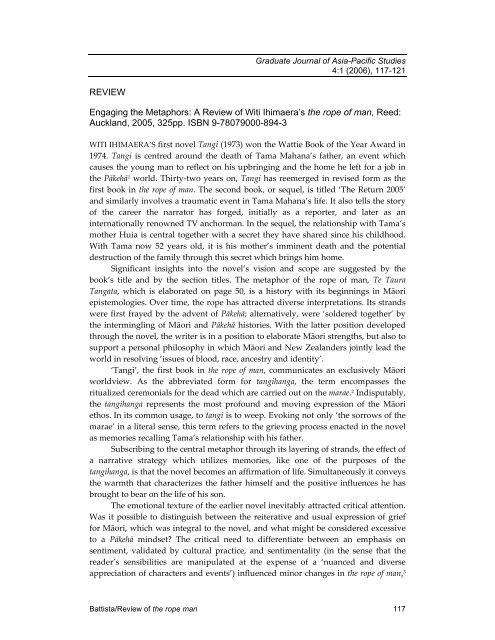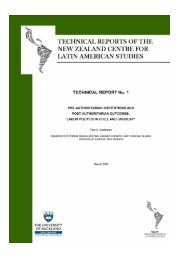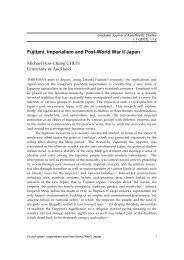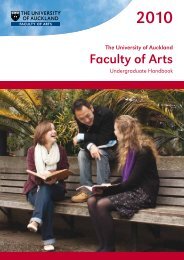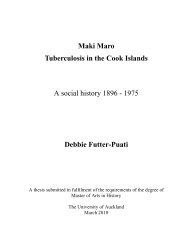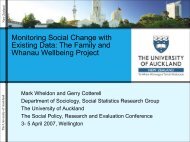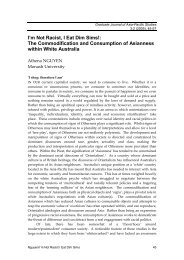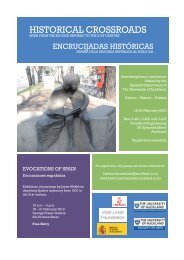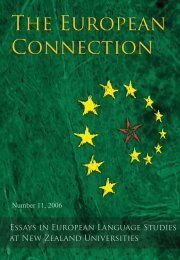Create successful ePaper yourself
Turn your PDF publications into a flip-book with our unique Google optimized e-Paper software.
Graduate Journal <strong>of</strong> Asia-Pacific Studies<br />
4:1 (2006), 117-121<br />
REVIEW<br />
Engaging <strong>the</strong> Metaphors: A <strong>Review</strong> <strong>of</strong> <strong>Witi</strong> <strong>Ihimaera</strong>’s <strong>the</strong> <strong>rope</strong> <strong>of</strong> <strong>man</strong>, Reed:<br />
Auckland, 2005, 325pp. ISBN 9-78079000-894-3<br />
WITI IHIMAERA’S first novel Tangi (1973) won <strong>the</strong> Wattie Book <strong>of</strong> <strong>the</strong> Year Award in<br />
1974. Tangi is centred around <strong>the</strong> death <strong>of</strong> Tama Mahana’s fa<strong>the</strong>r, an event which<br />
causes <strong>the</strong> young <strong>man</strong> to reflect on his upbringing and <strong>the</strong> home he left for a job in<br />
<strong>the</strong> Pākehā 1 world. Thirty‐two years on, Tangi has reemerged in revised form as <strong>the</strong><br />
first book in <strong>the</strong> <strong>rope</strong> <strong>of</strong> <strong>man</strong>. The second book, or sequel, is titled ‘The Return 2005’<br />
and similarly involves a traumatic event in Tama Mahana’s life. It also tells <strong>the</strong> story<br />
<strong>of</strong> <strong>the</strong> career <strong>the</strong> narrator has forged, initially as a reporter, and later as an<br />
internationally renowned TV anchor<strong>man</strong>. In <strong>the</strong> sequel, <strong>the</strong> relationship with Tama’s<br />
mo<strong>the</strong>r Huia is central toge<strong>the</strong>r with a secret <strong>the</strong>y have shared since his childhood.<br />
With Tama now 52 years old, it is his mo<strong>the</strong>r’s imminent death and <strong>the</strong> potential<br />
destruction <strong>of</strong> <strong>the</strong> family through this secret which brings him home.<br />
Significant insights into <strong>the</strong> novel’s vision and scope are suggested by <strong>the</strong><br />
book’s title and by <strong>the</strong> section titles. The metaphor <strong>of</strong> <strong>the</strong> <strong>rope</strong> <strong>of</strong> <strong>man</strong>, Te Taura<br />
Tangata, which is elaborated on page 50, is a history with its beginnings in Māori<br />
epistemologies. Over time, <strong>the</strong> <strong>rope</strong> has attracted diverse interpretations. Its strands<br />
were first frayed by <strong>the</strong> advent <strong>of</strong> Pākehā; alternatively, were ‘soldered toge<strong>the</strong>r’ by<br />
<strong>the</strong> intermingling <strong>of</strong> Māori and Pākehā histories. With <strong>the</strong> latter position developed<br />
through <strong>the</strong> novel, <strong>the</strong> writer is in a position to elaborate Māori strengths, but also to<br />
support a personal philosophy in which Māori and New Zealanders jointly lead <strong>the</strong><br />
world in resolving ‘issues <strong>of</strong> blood, race, ancestry and identity’.<br />
‘Tangi’, <strong>the</strong> first book in <strong>the</strong> <strong>rope</strong> <strong>of</strong> <strong>man</strong>, communicates an exclusively Māori<br />
worldview. As <strong>the</strong> abbreviated form for tangihanga, <strong>the</strong> term encompasses <strong>the</strong><br />
ritualized ceremonials for <strong>the</strong> dead which are carried out on <strong>the</strong> marae. 2 Indisputably,<br />
<strong>the</strong> tangihanga represents <strong>the</strong> most pr<strong>of</strong>ound and moving expression <strong>of</strong> <strong>the</strong> Māori<br />
ethos. In its common usage, to tangi is to weep. Evoking not only ‘<strong>the</strong> sorrows <strong>of</strong> <strong>the</strong><br />
marae’ in a literal sense, this term refers to <strong>the</strong> grieving process enacted in <strong>the</strong> novel<br />
as memories recalling Tama’s relationship with his fa<strong>the</strong>r.<br />
Subscribing to <strong>the</strong> central metaphor through its layering <strong>of</strong> strands, <strong>the</strong> effect <strong>of</strong><br />
a narrative strategy which utilizes memories, like one <strong>of</strong> <strong>the</strong> purposes <strong>of</strong> <strong>the</strong><br />
tangihanga, is that <strong>the</strong> novel becomes an affirmation <strong>of</strong> life. Simultaneously it conveys<br />
<strong>the</strong> warmth that characterizes <strong>the</strong> fa<strong>the</strong>r himself and <strong>the</strong> positive influences he has<br />
brought to bear on <strong>the</strong> life <strong>of</strong> his son.<br />
The emotional texture <strong>of</strong> <strong>the</strong> earlier novel inevitably attracted critical attention.<br />
Was it possible to distinguish between <strong>the</strong> reiterative and usual expression <strong>of</strong> grief<br />
for Māori, which was integral to <strong>the</strong> novel, and what might be considered excessive<br />
to a Pākehā mindset The critical need to differentiate between an emphasis on<br />
sentiment, validated by cultural practice, and sentimentality (in <strong>the</strong> sense that <strong>the</strong><br />
reader’s sensibilities are <strong>man</strong>ipulated at <strong>the</strong> expense <strong>of</strong> a ‘nuanced and diverse<br />
appreciation <strong>of</strong> characters and events’) influenced minor changes in <strong>the</strong> <strong>rope</strong> <strong>of</strong> <strong>man</strong>. 3<br />
Battista/<strong>Review</strong> <strong>of</strong> <strong>the</strong> <strong>rope</strong> <strong>man</strong> 117
For instance, italicized phrases deploying <strong>the</strong> voice and apprehension <strong>of</strong> <strong>the</strong> child<br />
Tama at an earlier family tangi have been downplayed in <strong>the</strong> later version.<br />
‘Tangi’ can justifiably claim passages <strong>of</strong> great lyric beauty. As <strong>the</strong> casket is<br />
lowered into <strong>the</strong> earth an analogy is made between <strong>the</strong> separation <strong>of</strong> husband and<br />
wife and <strong>the</strong> separation <strong>of</strong> <strong>the</strong> mythic parents Ranginui and Papatūānuku. The passage<br />
quoted here is taken from <strong>the</strong> earlier publication:<br />
‘Earth reaches for Sky and Sky bends to Earth. One last fierce clasp in rain and wind<br />
and wind and rain. One last embrace <strong>of</strong> rage and fury and helpless grief. One last<br />
clinging <strong>of</strong> body to body, <strong>of</strong> Earth to Sky. One last meeting <strong>of</strong> lips to lips and tears to<br />
tears.<br />
And <strong>the</strong>n <strong>the</strong> slow drawing away, <strong>the</strong> slow tearing away, <strong>the</strong> slow wrenching away <strong>of</strong><br />
Sky from Earth, <strong>of</strong> Earth from Sky, in <strong>the</strong> final, sorrowful separation . . .<br />
Farewell, e pa. Haere ra, my fa<strong>the</strong>r’. 4<br />
This version allowed me to refer in a previous critique to a ‘melancholia<br />
subsumed by a depth <strong>of</strong> grief and rage so pr<strong>of</strong>ound it assumes cosmic proportions‘.<br />
Through marginal changes to <strong>the</strong> revised text in <strong>the</strong> <strong>rope</strong> <strong>of</strong> <strong>man</strong> <strong>the</strong> word ‘fierce’<br />
becomes ‘passionate’ and ‘One last fierce clasp in rain and wind and wind and rain’<br />
is replaced by ‘One last embrace <strong>of</strong> joy and love and thankfulness’. 5 Perhaps<br />
intended to suggest a hope for healing <strong>the</strong> sentimental underlay in this revision is<br />
unequivocally absent in <strong>the</strong> original. In contrast a later exchange between mo<strong>the</strong>r<br />
and son in ‘The Return’ is almost tongue‐in‐cheek – ‘But sometimes I can become<br />
maudlin. Her words set me <strong>of</strong>f again and, when she saw I was still sorrowing, she<br />
got cross. “Oh, get over yourself,” she said’. 6<br />
In <strong>the</strong> <strong>rope</strong> <strong>of</strong> <strong>man</strong> <strong>the</strong> prevailing metaphor is streng<strong>the</strong>ned by ano<strong>the</strong>r<br />
whakataukii, or proverb: ‘Te torino haere whakamua, whakamuri. At <strong>the</strong> same time as<br />
<strong>the</strong> spiral is going forward, it is returning’. 7 Elsewhere, <strong>Ihimaera</strong> has referred to <strong>the</strong><br />
double spiral which allows you ‘to go back into history and <strong>the</strong>n come out again.<br />
Back from personal into political . . . [and] out again’. 8 The spiral is a t<strong>rope</strong> with a<br />
trajectory founded on Māori ways <strong>of</strong> perceiving <strong>the</strong> world and our place in it. One <strong>of</strong><br />
<strong>the</strong> distinctive aspects <strong>of</strong> <strong>the</strong> spiral formation is <strong>the</strong> seamless transition it influences<br />
between past and present, and between temporal and spatial. This sense <strong>of</strong> travelling<br />
between two worlds is heightened by imaginative depictions <strong>of</strong> <strong>the</strong> landscape seen<br />
through <strong>the</strong> windows <strong>of</strong> <strong>the</strong> train carrying <strong>the</strong> narrator to and from Wellington: ‘The<br />
train curves into <strong>the</strong> dark bleakness ahead, breaking through <strong>the</strong> rain. The carriage<br />
rocks and sways like a canoe adrift. The mountains are <strong>the</strong> ridged backbone <strong>of</strong> a<br />
giant fish’. 9<br />
Here, <strong>Ihimaera</strong>’s ability to integrate a mythic past into <strong>the</strong> text, in this instance<br />
Māui’s lifting <strong>of</strong> Aotearoa 10 from <strong>the</strong> ocean, validates <strong>the</strong> notion <strong>of</strong> a narrator with a<br />
lineage recorded in <strong>the</strong> contours <strong>of</strong> <strong>the</strong> earth – ‘My mo<strong>the</strong>r was <strong>the</strong> Earth. My fa<strong>the</strong>r<br />
was <strong>the</strong> Sky’. 11 Similar perceptions underline Tama’s wait for <strong>the</strong> flood <strong>of</strong> light to <strong>the</strong><br />
east <strong>of</strong> <strong>the</strong> plane when, returning from London with sleeping passengers around<br />
him, his karakia 12 echoes his fa<strong>the</strong>r’s salutation to <strong>the</strong> day which was ‘also a prayer:<br />
Ko Ranginui kei runga, ko Papatuanuku kei raro, tena korua’. 13<br />
Cultural beliefs such as <strong>the</strong>se sit comfortably with <strong>the</strong> writer’s ‘mind style’ 14 or<br />
habitual way <strong>of</strong> viewing <strong>the</strong> world. <strong>Ihimaera</strong> frequently expresses varying psychic<br />
118<br />
www.arts.auckland.ac.nz/gjaps
states in terms <strong>of</strong> light and darkness. Whe<strong>the</strong>r a metaphysical drifting – ‘The stars<br />
come out. My fa<strong>the</strong>r and I are floating on a luminescent skein <strong>of</strong> silver dreams’ 15 – or<br />
a perception <strong>of</strong> an actual experience – ‘<strong>the</strong> sky above Waituhi was like a funnel and<br />
all <strong>the</strong> stars <strong>of</strong> <strong>the</strong> Milky Way would shower down upon us’ 16 – <strong>the</strong>se impressions<br />
embody <strong>the</strong> universe we intuit in ourselves. Simultaneously <strong>the</strong>re is nothing<br />
incongruous about <strong>the</strong> philosophical attitude <strong>of</strong> <strong>the</strong> narrator and <strong>the</strong> down‐to‐earth,<br />
sometimes humorous, tone <strong>of</strong> writing describing Tama’s impoverished upbringing:<br />
‘<strong>the</strong> makeshift stops along <strong>the</strong> way – draughty shearing huts, shepherds’ quarters<br />
and one‐room scrubcutters’ shacks’ 17 ; hens ‘too accustomed to sleeping inside’ which<br />
‘before you know it’ will ‘be talking in Maori’. 18<br />
There is some irony, however, in <strong>the</strong> conjunction <strong>of</strong> diverse traditions and<br />
political perspectives conceptualised by <strong>the</strong> strands <strong>of</strong> a <strong>rope</strong> or <strong>the</strong> interstitial<br />
possibilities <strong>of</strong> <strong>the</strong> spiral. The implied freedom and orality <strong>of</strong> first‐person narration,<br />
for instance, and waiata tangi which blend naturally into <strong>the</strong> text, compare<br />
intriguingly with a somewhat cheeky decision and long encore in which a writer<br />
rewrites his own literary history. These are <strong>Ihimaera</strong>’s stories but <strong>the</strong> stories also own<br />
him. There are parallels between <strong>the</strong> <strong>rope</strong> <strong>of</strong> <strong>man</strong> and o<strong>the</strong>r texts, and it’s a burgeoning<br />
tale full <strong>of</strong> characters given prominence in o<strong>the</strong>r publications. Through <strong>the</strong> writer <strong>the</strong><br />
reader finds commonality in a place called Waituhi and an ancestral house called Te<br />
Rongopai.<br />
‘Rongopai rises up before you.<br />
The ro<strong>of</strong> holds up <strong>the</strong> sky. The foundations stand firmly in <strong>the</strong> earth. All hu<strong>man</strong>ity is<br />
<strong>the</strong>refore able to stand in <strong>the</strong> strand <strong>of</strong> life between, sustained by <strong>the</strong> strength <strong>of</strong> your<br />
ancestral house’. 19<br />
Apart from <strong>the</strong> author’s return to Waituhi, <strong>the</strong> interpretive possibilities <strong>of</strong> <strong>the</strong><br />
name <strong>of</strong> Rongopai and <strong>the</strong> interaction between its related meanings <strong>of</strong> ‘wellness’ and<br />
‘healing’ and <strong>the</strong> title <strong>of</strong> <strong>the</strong> sequel are intriguing in light <strong>of</strong> <strong>the</strong> novel’s plot and<br />
political vision. At first glance, <strong>the</strong> title, with its appended ‘2005’, simply seems to<br />
refer to <strong>the</strong> fact <strong>of</strong> <strong>the</strong> narrator’s return because <strong>of</strong> his mo<strong>the</strong>r’s illness. Rongopai’s<br />
history and name – <strong>the</strong> Gospel or good news – is <strong>the</strong> key, however, to a fuller<br />
appreciation <strong>of</strong> <strong>the</strong> novel’s complexities and a dynamic based on notions <strong>of</strong> survival,<br />
healing and conciliation.<br />
Ringatū oral tradition records how Te Rongopai was one <strong>of</strong> four houses erected<br />
to welcome Te Kooti’s return to Poverty Bay. 20 These wharenui (meeting houses) were<br />
named for focal words in Te Kooti’s prophecy announced to four elders <strong>of</strong> <strong>the</strong><br />
Ringatū faith – ‘Whakahaungia te rongopai i runga i te ngāwari me te aroha’. 21 The<br />
gospel was to be built on love and charity, <strong>the</strong> religious paradigm anticipating<br />
conciliation between Te Kooti and government, settlers and various Māori factions.<br />
Te Kooti never received <strong>the</strong> approval from <strong>the</strong> government so never returned to <strong>the</strong><br />
area: ‘I have no regrets or judgements about life and about our life. Perhaps it’s<br />
because <strong>the</strong>re was always a certain fatalism anyway about our situation as <strong>the</strong> last <strong>of</strong><br />
<strong>the</strong> Ringatu. As followers <strong>of</strong> Te Kooti Arikirangi, who had led us during <strong>the</strong> wars, we<br />
would always wander as <strong>the</strong> morehu, <strong>the</strong> lost people, until fortune’s wheel returned<br />
us to our promised land’. 22<br />
On an emotional level, <strong>the</strong> family has to survive <strong>the</strong> death <strong>of</strong> <strong>the</strong> fa<strong>the</strong>r. Acerbic<br />
Battista/<strong>Review</strong> <strong>of</strong> <strong>the</strong> <strong>rope</strong> <strong>man</strong> 119
exchanges between Tama and his siblings foreground <strong>the</strong> principle <strong>of</strong> morehu or<br />
survival, in practical terms as well; <strong>the</strong>y have to survive his defection when he<br />
chooses not to honour <strong>the</strong> obligation to return and care for <strong>the</strong>m after <strong>the</strong>ir fa<strong>the</strong>r’s<br />
death. Huia and Tama have to survive not only an event, which has haunted <strong>the</strong>m<br />
for years, but its outcome:<br />
‘I watched Eric Amundsen, repelled by him and angered at myself for bringing Mum<br />
to see him. . . .<br />
“Eric keeps seeing a huge glowing river”, Dr Stephens explained. “It’s a river that<br />
comes out <strong>of</strong> nowhere and recedes into some darkness way beyond <strong>the</strong> room he is in,<br />
In our sessions with him, Eric has been able to tell us about <strong>the</strong> river. It’s <strong>the</strong> most<br />
beautiful thing he has ever seen. It’s threaded with <strong>man</strong>y colours, like a glorious<br />
rainbow. There are voices in <strong>the</strong> river and <strong>the</strong>y are calling him”. . . . .<br />
“It isn’t a river”, I said’. 23<br />
The most powerful moment in ‘The Return, 2005’ describes <strong>the</strong> ascent onto <strong>the</strong> marae<br />
<strong>of</strong> <strong>the</strong> group from <strong>the</strong> psychiatric facility:<br />
‘I watched Eric Amundsen as he approached. He was making swimming movements<br />
with his arms, his eyes were glowing with gladness. What did he see as he swam<br />
towards <strong>the</strong> river that wasn’t a river . . . .<br />
For two years he had been dreaming <strong>of</strong> a river and had tried to join its stream, but it<br />
wasn’t a river. Spiralling out <strong>of</strong> nowhere was a <strong>rope</strong> stretching from <strong>the</strong> beginning to<br />
<strong>the</strong> end <strong>of</strong> time . . . .<br />
This time as he swam towards <strong>the</strong> river, <strong>the</strong> <strong>rope</strong> recognised him’. 24<br />
Permitted to embrace his Māori ancestry this <strong>man</strong> may now benefit from its<br />
distinctive knowledges and practices. There are implications here too for <strong>the</strong> future<br />
in <strong>the</strong> idea <strong>of</strong> an adoptive Pākehā mo<strong>the</strong>r seeking a Māori healing for her son.<br />
<strong>the</strong> <strong>rope</strong> <strong>of</strong> <strong>man</strong> successfully communicates <strong>the</strong> need to realise a sense <strong>of</strong><br />
belonging and place, one which allows us to appreciate our cultural diversity.<br />
Occasionally pretentious, <strong>the</strong> novel supports a national identity with expatriates torn<br />
between staying and returning who address <strong>the</strong> narrator as ‘sir’. 25 Its characters are<br />
credible; even a narrator with a lop‐sided grin disconcertingly close to <strong>the</strong> writer’s<br />
own. Its catalogue <strong>of</strong> major media events over <strong>the</strong> last thirty years and <strong>the</strong> level <strong>of</strong><br />
research it has required is especially evident in <strong>the</strong> international broadcast <strong>of</strong> <strong>the</strong><br />
finale. This emphasis embraces a global community and sustains <strong>the</strong> notion <strong>of</strong> our<br />
common hu<strong>man</strong>ity.<br />
The novel concludes with <strong>the</strong> words ‘We bow only to <strong>the</strong> highest mountain’. 26<br />
This final statement in English is a commentary on <strong>the</strong> calibre <strong>of</strong> Māori and New<br />
Zealanders. Only one point back on <strong>the</strong> curve <strong>of</strong> <strong>the</strong> spiral and <strong>the</strong> pepeha 27 is in<br />
Māori: ‘Me te tuohu koe, me tuohu ki te maunga teitei’. 28 This tribal saying is not a<br />
measure <strong>of</strong> defeat, it attests to <strong>the</strong> values and <strong>the</strong> <strong>man</strong>a 29 <strong>of</strong> <strong>the</strong> Māori people.<br />
Jon BATTISTA<br />
University <strong>of</strong> Auckland<br />
120<br />
www.arts.auckland.ac.nz/gjaps
NOTES<br />
1<br />
Pākehā is <strong>the</strong> common term for a New Zealander <strong>of</strong> Eu<strong>rope</strong>an descent.<br />
2<br />
Marae refers to ei<strong>the</strong>r <strong>the</strong> enclosed complex where <strong>the</strong> meeting house and o<strong>the</strong>r buildings are<br />
located or to <strong>the</strong> open space in front <strong>of</strong> <strong>the</strong> meeting house where formalities take place.<br />
3<br />
N. Simms, ‘A Maori Literature In English . . .’, Pacific Quarterly, 3, 3 (1978), p. 339.<br />
4<br />
<strong>Witi</strong> <strong>Ihimaera</strong>, ‘Tangi (extract from <strong>the</strong> novel)’, in <strong>Witi</strong> <strong>Ihimaera</strong> and D. S. Long, eds., Into <strong>the</strong> World<br />
<strong>of</strong> Light: An Anthology <strong>of</strong> Maori Writing, Heine<strong>man</strong>n, Auckland, 1982, p.242.<br />
5<br />
<strong>Witi</strong> <strong>Ihimaera</strong>, <strong>the</strong> <strong>rope</strong> <strong>man</strong>, Reed, Auckland, 2005, p.156.<br />
6<br />
ibid., p.315.<br />
7<br />
ibid., p.271.<br />
8<br />
Cited in Elizabeth DeLoughrey, Routes and Routes: Navigating Caribbean & Pacific Island Literatures,<br />
University <strong>of</strong> Hawai‘i Press, Hawai’i, forthcoming, p.218.<br />
9<br />
<strong>Ihimaera</strong>, <strong>the</strong> <strong>rope</strong> <strong>man</strong>, p.160.<br />
10<br />
New Zealand.<br />
11<br />
<strong>Ihimaera</strong>, <strong>the</strong> <strong>rope</strong> <strong>man</strong>, p.200.<br />
12<br />
An incantation but more commonly in modern usage referring to ‘prayer’.<br />
13<br />
<strong>Ihimaera</strong>, <strong>the</strong> <strong>rope</strong> <strong>man</strong>, p.31.<br />
14<br />
‘mind style’ – A term used in stylistics denoting a writer’s characteristic way <strong>of</strong> perceiving and<br />
depicting <strong>the</strong> world. See Ge<strong>of</strong>frey N. Leech and Michael H. Short. Style In Fiction: A linguistic<br />
introduction to English fictional prose. English Language Series 13, Long<strong>man</strong>, London and New York,<br />
pp.187‐207.<br />
15<br />
<strong>Ihimaera</strong>, <strong>the</strong> <strong>rope</strong> <strong>man</strong>, p.28.<br />
16<br />
ibid., p.85.<br />
17<br />
ibid., p.35.<br />
18<br />
ibid., p.37.<br />
19<br />
ibid., p.110.<br />
20<br />
Te Kooti Arikirangi Te Turuki <strong>of</strong> <strong>the</strong> Rongowhakaata Iwi (tribe) <strong>of</strong> Turanganui a Kiwa (Gisborne)<br />
achieved a national pr<strong>of</strong>ile when he founded <strong>the</strong> Ringatu faith, a faith ‘born directly out <strong>of</strong> conflict over<br />
land between Maori and Pakeha’ which was based on doctrines promising release from bondage and<br />
<strong>the</strong> return <strong>of</strong> land to his people. In 1866 he was falsely accused <strong>of</strong> collaborating with <strong>the</strong> Taranaki Forces<br />
during <strong>the</strong> Waerenga a Hika conflict and imprisoned without trial at <strong>the</strong> Wharekauri penal settlement.<br />
After escaping in 1868 he maintained an active resistance until 1874 when he took refuge in <strong>the</strong> King<br />
Country. He received a pardon from <strong>the</strong> Crown in 1883. Te Kooti Arikirangi Te Turuki, online,<br />
http://aotearoa.wellington.net.nz/back/kooti.htm.<br />
21<br />
Roger Neich, Painted Histories:Early Maori figurative painting, Auckland University Press, Auckland,<br />
1993, p.189.<br />
22<br />
<strong>Ihimaera</strong>, <strong>the</strong> <strong>rope</strong> <strong>man</strong>, p.35.<br />
23<br />
ibid., p.288.<br />
24<br />
ibid., p.313.<br />
25<br />
ibid., p.181.<br />
26<br />
ibid., p.322.<br />
27<br />
A tribal saying; a proverb.<br />
28<br />
<strong>Ihimaera</strong>, <strong>the</strong> <strong>rope</strong> <strong>man</strong>, p.322.<br />
29<br />
Mana is prestige, power, influence or/and authority.<br />
Battista/<strong>Review</strong> <strong>of</strong> <strong>the</strong> <strong>rope</strong> <strong>man</strong> 121


